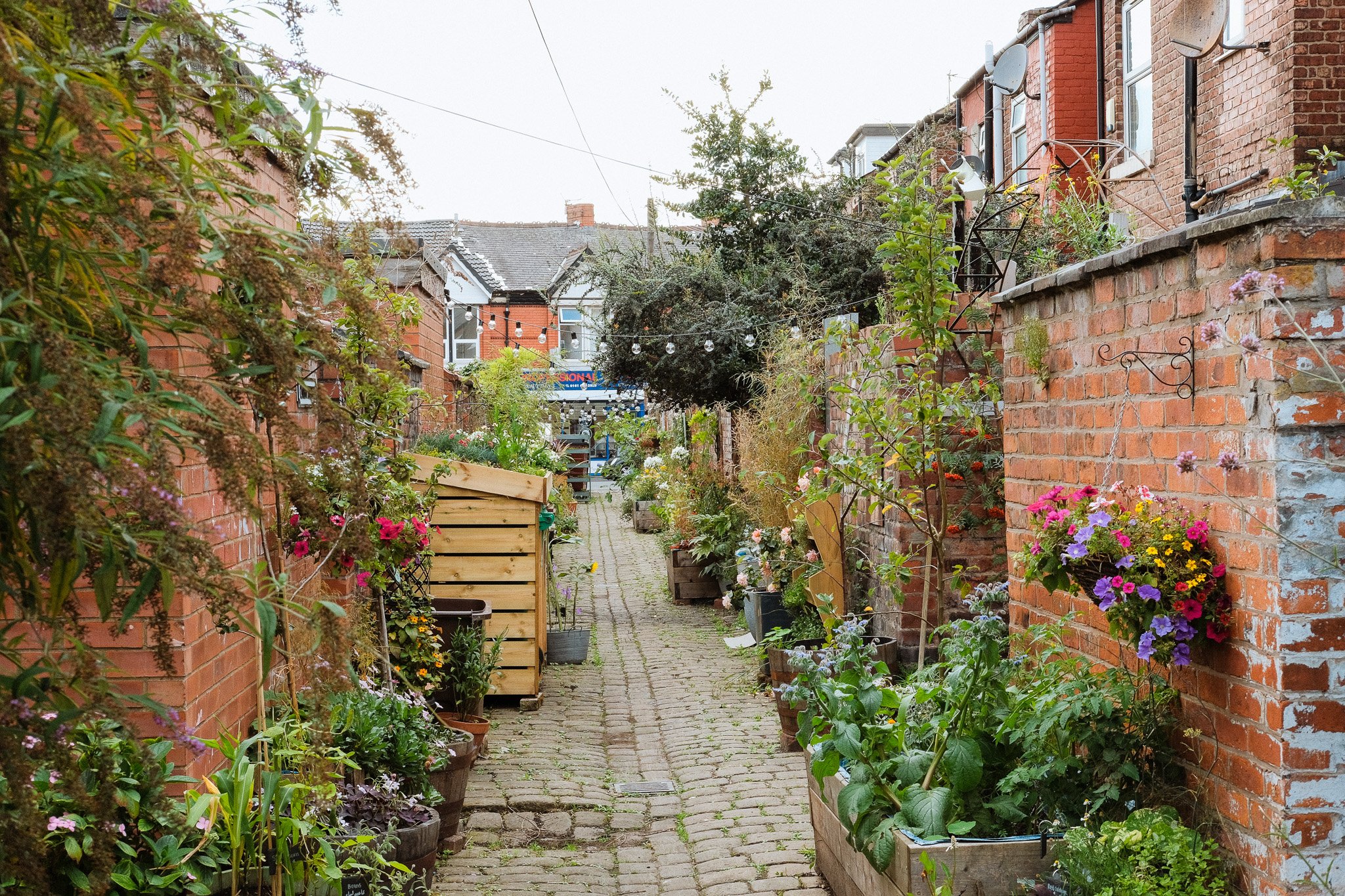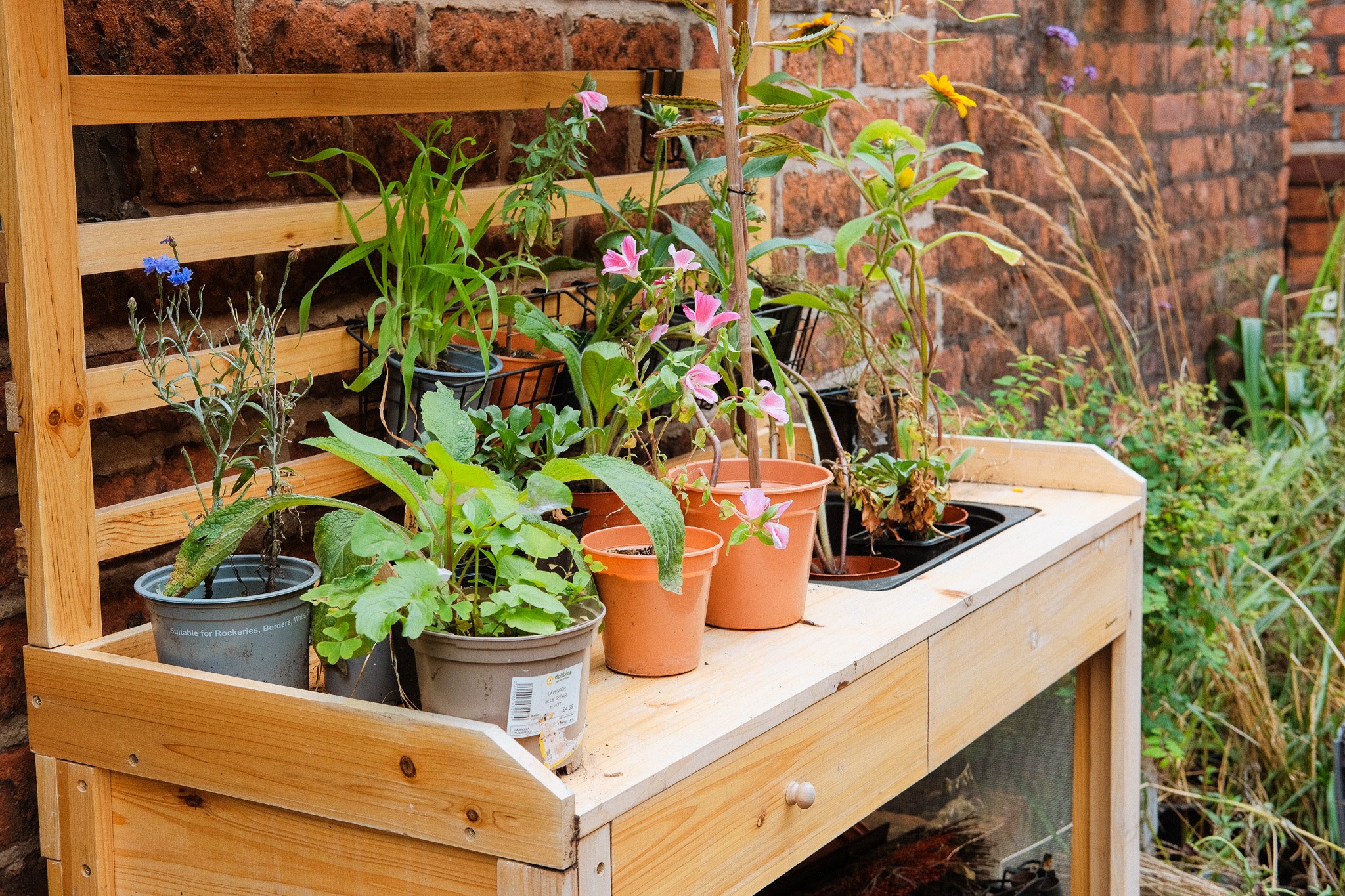How to green your alleyway
Alleyways, Ginnels or Alleys? Whatever you call them, these shared spaces are a staple feature in Greater Manchester’s landscape which have been connecting neighbours for over 100 years.
Despite lots of us having access to alleyways all over Manchester, they’re often underused and neglected spaces. Where we often associate alleys with things like our bins, or annoying cases of fly tipping, a new wave of neighbourhood gardeners have started to explore the potential that our cobbled ginnels have to become beautiful green spaces which can help us to connect with nature and our community.
This guide - adapted from this article initially created by Groundwork Manchester - was created to help showcase the benefits of alleyway gardening, and help you to get started in greening your own alleyways by giving you all the tips and tricks you need to get you started on your gardening journey.
What are the benefits of alleyway greening?
Here are just a few of the wonderful benefits of starting an alleyway garden project:
Bringing nature into urban spaces
Providing safer space for children to play
Meeting and relaxing with neighbours
Creating ‘wildlife corridors’ and habitats for bees, butterflies and other pollinators
Feeling more pride and belonging in your neighbourhood
Reducing fly tipping and litter
Improving recycling rates
Learning new DIY, gardening and growing skills
Improving mental health and wellbeing
Getting started on your alleyway
Step 1 – Find inspiration from other alleyway projects
There are a bunch of alleyways already blooming all over Manchester, and they’re packed with great ideas which you can use as inspiration for your own brilliant ginnel gardens.
Check out our instagram post highlighting some of the alleyways we’re following on social media.
Take a walk around your neighbourhood, reach out to other groups and request a visit, and keep searching social media for other projects.
Be sure to also check out Upping It; a Moss Side based urban greening project.
Step 2 – Take some before photos!
Take photos of what your alleyway looks like before you get started on your community project, and as you begin working on it, so you have some pictures to demonstrate the difference community action can have. This will help recruit neighbours to become involved and keep volunteers motivated.
Step 3 – Start reporting any fly tipping
By regularly reporting fly tipping and litter on your council’s website, action will be taken to tidy it up and deter people from doing it again. Keeping your alleyways as tidy as possible will put people off leaving rubbish there in the first place, and hopefully motivate your neighbours to help keep them clean.
Bringing your community together
No community project is complete without a dedicated group of people to make it happen. Here are some top tips for encouraging others to get involved.
Talk to your neighbours
You’ll ideally need a core group of dedicated people for the project to become a success and manage the workload (teamwork makes the dream work!). You should look to recruit a handful of people from local households so there’s enough of you to help set up the project and maintain the community planting. The best way to find people is simply to knock on your neighbour’s doors and speak to them about your ideas.
Make a leaflet
It’s not always possible to get hold of your neighbours by knocking on doors, so why not try creating a quick leaflet or flyer which you can post to houses on your street and invite people to get involved. Canva is an easy to use and free online resource packed full of template posters and leaflets which you can easily edit and print.
Stay Connected
Setting up a WhatsApp group or Facebook page is a great way to keep interested neighbours connected and updated as you plan ahead and mantain your alleyway.
Getting permissions for alleyway greening
The legalities of planning a project like this can be tricky to work around.
Firstly, speak to your local councillors, council neighbourhood officers or housing organisations for advice on permissions for carrying out improvements in your chosen space. Contact details for these people can typically be found on your local council website.
Make sure to take a look at the land registry too to find out about any restrictions you need to consider.
If you are struggling with gaining permission or are experiencing long delays, you can normally get started with small improvements. As long as materials are moveable and you are able to take care of the space, most landowners are happy to see spaces improved for community benefit.
Maintaining your alleyway
Many community groups find that maintaining their alleyway can be a bit of a challenge, so here are a few pieces of advice to ensure you and your neighbours can maintain momentum.
The first tidy up day can generate the most interest, so make sure you maximise this! Make sure everyone who attends joins your WhatsApp / Facebook / social media group, and make sure you have follow up action days in the diary to keep people interested.
Make your alleyway improvements small and simple at first. Creating big, ambitious projects, although exciting, can put people off and may lead to your core group of volunteers to become burnt out. Start small and build on your alleyway greening over time. Remember, this should be fun, not overwhelming!
If you or your neighbours have practical DIY skills or gardening skills, make sure these are shared with others. People love learning new skills, plus, by sharing skills you can distribute tasks so they don’t all fall to one person.
Finding materials for your alleyway
Alleyways can require plants, plant pots and all sorts of other materials to bring them to life. But don’t worry, you don’t need to spend loads of money to get started. There are many different avenues to explore when it comes to building up your alley greening project…
Speak with your council
Contact your local council or councillor for litter pickers and binbags to get you started with tidy up days. Many councils organise jet washes of your alley, quickly creating a clean canvas for you to start with.
Source donations
It’s amazing what you can find through donations if you just ask! Speak to local businesses or supermarkets to see if they have any spare plants or bulbs. Community garden centres such as Hulme Garden Centre often have reuse schemes where you can pick up spare plant pots for free.
The B&Q Community Reuse Scheme also offers materials for free for community projects – from wood offcuts, paint, plants and plant pots.
See what you might have already available
Some alleyway projects have started using discarded bathtubs, washing machine drums, and all sorts of other leftover bits and bobs that they’ve found in their alleyways as planters, benches, seating areas, and more. You can also use discarded bricks, wooden pallets, or old furniture to modify and create new homes for your plants - and they give our alleyways a unique DIY look!
Applying for funding
It’s easier to apply for grant funding if your community group becomes ‘constituted’. This process requires your group of volunteers to adopt a constitution – setting out the name and purpose of your group, group members and roles, processes you will follow, health and safety, and so on. You will then be able to set up a bank account, apply for grants, buy insurance, purchase your own equipment and even employ staff. However, we would suggest exploring the above options before making this commitment as it may become a distraction from your core project.
A few funding streams are available in Greater Manchester (as of January 2023):
The Greater Manchester Greenspace Fund supports community-led projects that increase the amount and quality of accessible, nature-rich green space in the city region, particularly in the areas where people need it most.
Tesco community grants offer up to £1500 funding for community groups through their ‘blue tokens’ scheme, where Tesco shoppers vote in stores for three local good causes every three months.
Be sure to check with your local council too, as they may also have funding available for local community projects.







